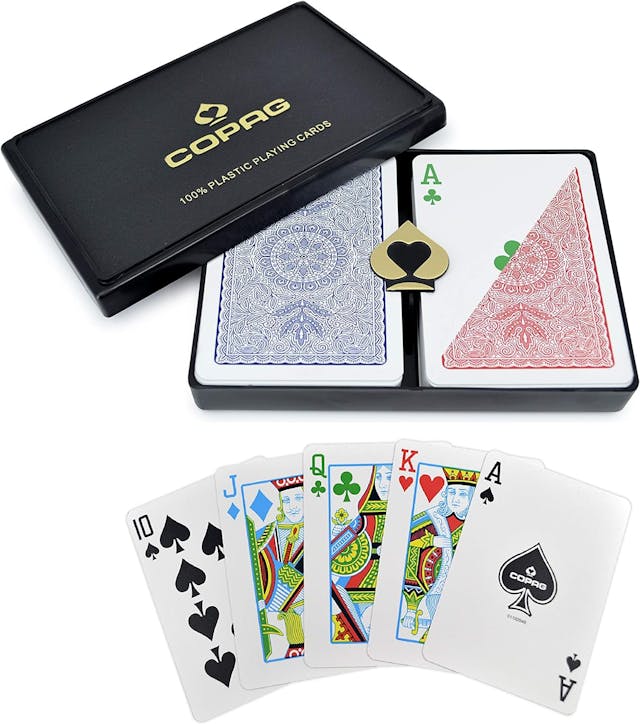Ryan Anderson | July 22, 2021
The 4-Color Deck Edition
On poker, playing cards, and designing a differentiated deck
Recommended Products

Physical decks of 4-color playing cards.
Ryan Anderson (RJA) is joining us for his fifth WITI, having previously written about Video Assisted Review, The Richest Game, Counties, and Semiconductors. He is a marketing director based in Atlanta, GA, and has previously lived in Maine, Bermuda, Texas, LA, and NYC.
Ryan here. My college years were perfectly timed with the online poker boom. In August of 2002, I started at Georgia Tech, bringing with me the strong mathematics background that would imply. Just nine months later, in May of 2003, an accountant from Tennessee named Chris Moneymaker won the World Series of Poker main event. Suddenly, everyone wanted to be the next poker millionaire.
While late-night poker games have long been a right of passage for young people, the proliferation of high-speed internet and launch of online poker rooms revolutionized the playing experience. Games of all stakes and formats were suddenly available around the clock, and players soon learned that you could “sit down” at more than one table at a time.
Many of these “multi-tablers” (as people who played more than one game at a time came to be known) started using 4-color decks in an effort to reduce confusion between suits. But 4-color decks weren’t an innovation from the computer age. Far from it.
Why is this interesting?
Playing cards go back at least to 9th century China and quickly spread across the ancient world. Some of the details in early packs were incredible, bearing more resemblance to tarot cards than the playing cards we use today.
https://commons.wikimedia.org/wiki/File:Mamluk_kanjifah_cards.png
https://commons.wikimedia.org/wiki/File:Viscontisforzatarot.jpg
Over time the concept of suits and ranks evolved, and by around the late 1400s, we had the French Suits you are likely familiar with: clubs, diamonds, hearts, and spades. In the early 1500s, the “English pattern” deck (52 cards, Ace through King in 4 suits, designs only on the face cards) had emerged as the favored choice, and card games were off to the races.
This wasn’t the end of card design evolution though. As card games got more complex, and as more upper-class members of society were playing them, updated designs began to appear. By the early 1900s, a number of companies were creating 4-color decks marketed for bridge players. In these decks the diamonds were blue and the clubs were green—helping to clarify play in trick-taking games.
If you’re not used to this, the visual can be jarring.
So jarring, in fact, that some players revolt when they see them. In 1995, Mike Caro, the poker player, gambling author, and (crucially for this story) casino executive rolled out 4-color decks across 65 casinos. The experiment was poorly received.
But, Mike’s dreams were unbelievably, stunningly, horribly dashed that day. Mike remembers that the managers reported a “stunned silence” at this sudden change in the color of the cards on that fateful day. The players were unsure about this unusual break with the traditional colors. Although most players seemed impressed, some were indifferent and then there were those who voiced their discontent rather loudly. There were a few who took this opportunity to blame their misfortune on the color change at their tables.
But while the four-color deck never really took off for physical card games, they did see adoption in online poker. And the reason was as simple as increased earning potential.
For the sake of this example, let’s consider limit hold’em poker, where there is a cap on the amount you can wager and how many times a player can raise. A good online poker player could expect to make 3 BB/100 (big bets per 100 hands). In other words, if this player was playing a $10/$20 game ($10 bet increments during the first two rounds of betting, $20 bet increments on the final two rounds) they could expect to make $60 every 100 hands, on average. Online tables are much faster than casino poker rooms, so you may be able to get in 60 hands per hour, meaning your hourly rate would work out to $36/hr.
But online poker allows you to play multiple tables at once. Sitting down at 4 tables at the same time may have a negative impact on your win rate, but the volume would more than make up for it. If a player’s win rate dropped from 3 BB/100 to 2.5 BB/100 they would still see their hourly rate increase from $36 to $120.
In order to maintain a relatively high win rate, players wanted to be absolutely sure of what was in their hand. And that’s where the 4-color deck came in. Players no longer had to worry about mistaking a heart for a diamond and misreading their opponents’ flush (5 cards of a single suit) possibilities, limiting the chances of making a major mistake.
Today, every major online poker room offers a 4-color deck option for players. The feature has even made it all the way down to the “play with your friends on Zoom” platforms that popped up during the pandemic, such as WITI Poker Night favorite Donkhouse. (RJA)
Soccer Goal of the Day:
The best goal scored in international soccer over the past couple months wasn’t in the Euros or Copa America, it was by the US Womens National Team. (RJA)
Quick Links:
If this caught your fancy, you can buy physical decks of 4-color cards. (RJA)
Calling back to my previous WITI, Intel is said to be considering acquiring GlobalFoundries for $30 billion. (RJA)
On the rise of Spotify streaming farms(RJA)
Thanks for reading,
Noah (NRB) & Colin (CJN) & Ryan (RJA)
Why is this interesting? is a daily email from Noah Brier & Colin Nagy (and friends!) about interesting things. If you’ve enjoyed this edition, please consider forwarding it to a friend. If you’re reading it for the first time, consider subscribing (it’s free!).



